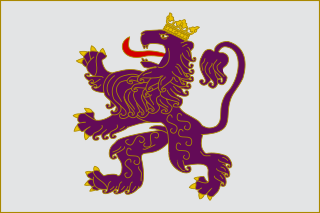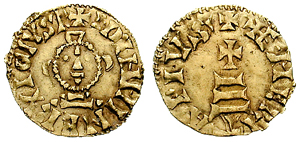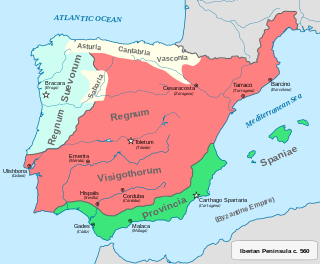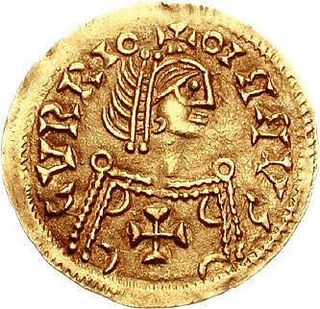
The Battle of Guadalete was the first major battle of the Umayyad conquest of Hispania, fought in 711 at an unidentified location in what is now southern Spain between the Christian Visigoths under their king, Roderic, and the invading forces of the Muslim Umayyad Caliphate, composed mainly of Berbers and some Arabs under the commander Ṭāriq ibn Ziyad. The battle was significant as the culmination of a series of Berber attacks and the beginning of the Umayyad conquest of Hispania. Roderic was killed in the battle, along with many members of the Visigothic nobility, opening the way for the capture of the Visigothic capital of Toledo.

The Kingdom of León was an independent kingdom situated in the northwest region of the Iberian Peninsula. It was founded in 910 when the Christian princes of Asturias along the northern coast of the peninsula shifted their capital from Oviedo to the city of León. The kings of León fought civil wars, wars against neighbouring kingdoms, and campaigns to repel invasions by both the Moors and the Vikings, all in order to protect their kingdom's changing fortunes.

Christian monasticism is the devotional practice of Christians who live ascetic and typically cloistered lives that are dedicated to Christian worship. It began to develop early in the history of the Christian Church, modeled upon scriptural examples and ideals, including those in the Old Testament. It has come to be regulated by religious rules and, in modern times, the Canon law of the respective Christian denominations that have forms of monastic living. Those living the monastic life are known by the generic terms monks (men) and nuns (women). The word monk originated from the Greek μοναχός, itself from μόνος meaning 'alone'.

Erwig was a king of the Visigoths in Hispania (680–687).

Wittiza was the Visigothic King of Hispania from 694 until his death, co-ruling with his father, Egica, until 702 or 703.
Julian of Toledo (642–690) was born in Toledo, Hispania. He was well educated at the cathedral school, was a monk and later abbot at Agali, a spiritual student of Saint Eugene II, and archbishop of Toledo. He was the first bishop to have primacy over the entire Iberian Peninsula—a position he has been accused of securing by being complicit in 680 in the supposed poisoning of Wamba, king of the Visigoths—and he helped centralize the Iberian Church in Toledo. His elevation to the position of primate of the Visigothic church was a source of great unhappiness among the kingdom's clergy. And his views regarding the doctrine of the Trinity proved distressing to the Vatican.

Lérins Abbey is a Cistercian monastery on the island of Saint-Honorat, one of the Lérins Islands, on the French Riviera, with an active monastic community.

Ildefonsus or Ildephonsus was a scholar and theologian who served as the metropolitan Bishop of Toledo for the last decade of his life. His Gothic name was Hildefuns. In the Ethiopian Orthodox Tewahedo Church he is known as Dexius based on the Ge'ez translation of legends about his life.

February 17 - Eastern Orthodox liturgical calendar - February 19

Fructuosus of Braga, Bishop of Dumio and Archbishop of Braga, a great founder of monasteries, died on 16 April 665. The son of a Visigothic dux in the region of Bierzo, at a young age he accompanied his father on official trips over his estates. After a period spent as a hermit, he established a monastery at Complutum and became its first abbot.
Eugenius I was Archbishop of Toledo from 636 to 646. He is also known as an astronomer and astronomical mathematician.

Spania was a province of the Eastern Roman Empire from 552 until 624 in the south of the Iberian Peninsula and the Balearic Islands. It was established by the Emperor Justinian I in an effort to restore the western provinces of the Empire.

Eastern Christian monasticism is the life followed by monks and nuns of the Eastern Orthodox Church, Oriental Orthodoxy, the Church of the East and Eastern Catholicism. Eastern monasticism is founded on the Rule of St Basil and is sometimes thus referred to as Basilian.

The Visigothic Kingdom, Visigothic Spain or Kingdom of the Goths occupied what is now southwestern France and the Iberian Peninsula from the 5th to the 8th centuries. One of the Germanic successor states to the Western Roman Empire, it was originally created by the settlement of the Visigoths under King Wallia in the province of Gallia Aquitania in southwest Gaul by the Roman government and then extended by conquest over all of Hispania. The Kingdom maintained independence from the Eastern Roman or Byzantine Empire, whose attempts to re-establish Roman authority in Hispania were only partially successful and short-lived.

Mozarabic art is an early medieval artistic style that is part of the pre-Romanesque style and is linked to the kingdom of León. It was developed by the Hispanic Christians who lived in Muslim territory and in the expansion territories of the León crown, in the period from the Muslim invasion (711) to the end of the 11th century. During this period, disciplines such as painting, goldsmithing and architecture with marked Caliphate influences were cultivated in a context of medieval coexistence - Christian, Hebrew and Muslim - in which the territories were constantly changing in size and status. Other names for this artistic style are Leonese art or repopulation art.

The Archdiocese of Mérida–Badajoz is a Latin Church ecclesiastical territory of the Catholic Church in Spain, created in 1255. Until 1994, it was known as the Diocese of Badajoz.
Protofeudalism is a concept in medieval history, especially the history of Spain, according to which the direct precursors of feudalism can be found in Late Antiquity.

Valerio of El Bierzo was an ascetic hermit and monk from the Bierzo region of Visigothic Spain. A number of his writings still survive, including three short autobiographical works in which he complains about his many sufferings.

Helladius, Eladio or Elladio of Toledo was a Christian archbishop. Born into a Visigothic noble family in Spain, he initially held important positions at court but was attracted to the monastic life and took his vows at the Agali monastery. He became its abbot and later archbishop of Toledo. The Roman Martyrology gives his feast as 18 February.

Toledo is the repository of more than 2000 years of history. Successively a Roman municipium, the capital of the Visigothic Kingdom, a major city in Al-Andalus and the Kingdom of Castile. Its many works of art and architecture are the product of three major religions – Judaism, Christianity and Islam.